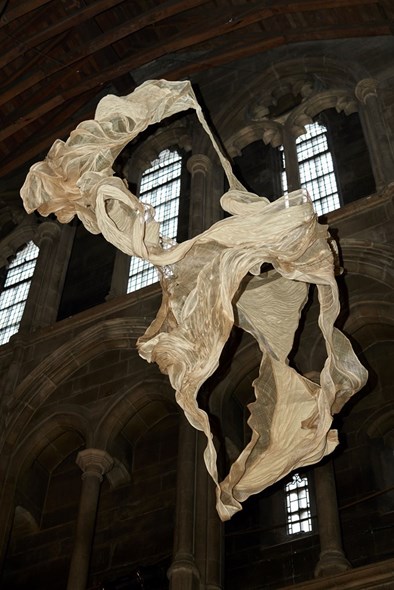COMPRISING a selection of specially made and existing works sensitively positioned, “Slipping the Veil” represents a dialogue with the architecture, history, and use of St Bartholomew the Great, Smithfield, in the City of London.
The exhibition is the second in a series of group shows in the space curated by artist-in-residence Elena Unger, on this occasion in collaboration with the James Freeman Gallery. These exhibitions complement and converse with the art works regularly displayed in the building, which include work by Sophie Arkette, Damien Hirst, Alfredo Roldan, and Josefina de Vasconcellos.
One element of the dialogue with Great St Bart’s initiated by the exhibition is its curation. Curating exhibitions in sacred spaces creates unique challenges through the interaction with the building’s history, restrictions regarding how and where works can be hung or shown, the extent to which the architecture can overwhelm the work, and the need to ensure that worship, prayer, pastoral care, and reflective space all continue without being hindered by the exhibition.
The curators have installed the exhibition with great sensitivity to the space — utilising, at different points, ceilings, floors, ledges, monuments, niches, sills, and walls — combined with understanding of the ways in which the art interacts with the location.
The Franklin Monument by Jake Evans is the piece that demonstrates the greatest rigour in its interaction. Evans 3D-scanned fragments of the building’s Gothic architecture to digitally re-model these for a new sculptural composition using CNC carving. Connecting with the building’s history, which includes Benjamin Franklin working a printing press in what is now the Lady Chapel, the work also has a scrolling LED display of quotations attributed to Franklin. The work and its niche display refer to this church’s engagement with labour and communication, plus the language of US roadside churches, and the history of architectural recesses. As the catalogue entry states, this piece “stages a conversation between the old and the reconstituted, the devotional and the digital”.
Carolein Smit is a Dutch artist whose work featured in the first group exhibition here and has also been seen in a recent exhibition at the James Freeman Gallery. Her ceramic sculptures allude to mythology, religious iconography, and art history to explore how beauty and horror overlap. Her practice reimagines ancient narrative archetypes and presents them with theatrical overtones to lend them a contemporary sensibility.
In her work, everything shines and glitters and is adorable through its exquisite detail and jewel-like form but is ultimately about “the turning point where seriousness becomes melodramatic, beauty turns into overkill and love becomes hate”. Her Grail is a glazed earthenware evocation of the Holy Grail, where drops of blood theatrically spill over from the jewel-encrusted chalice to run down its sides. The theatricality of her work, which is a form of memento mori, is enhanced by its positioning on the marble shelf of one of the church’s many monumental memorials.
 Diana Orving, Shapeshifter (2024), sculpture in abacá fibre
Diana Orving, Shapeshifter (2024), sculpture in abacá fibre
Diana Orving’s Shapeshifter sculpture in abacá fibre is hung from the ceiling in the north aisle, enabling differing views from below and also across from the south aisle. This cloud-like textile sculpture hovers in the air, capturing movement in stillness, and evokes a higher state of becoming. Edgar Ward’s sculptures depict figures entering dark and cavernous spaces surrounded by towering canopies. These evoke myths of journeys into the unknown, such as the dark wood that Dante enters at the beginning of Inferno.
The portals in Ward’s sculptures, however, could also equate to the experience of those entering the cavernous yet strangely intimate spaces of Great St Bart’s. Hand-built in white porcelain, sometimes with touches of blue or gold, Claire Curneen’s sculptures, with their translucent and fragile qualities, offer metaphors through which to consider the human condition and experience. Her work alludes to Catholic imagery from the early Italian Renaissance, in particular.
The show also includes visual installations by an international group of artists, including painters Elena Unger, Maxim Burnett, Ben Jamie, and textile painter Anne von Freyburg, and large-scale installations by Juliette Losq and Kate McDonnell which make monumental interventions into the space.
The exhibition is also supplemented by immersive sound and words from musician Nick Cave. His album Seven Psalms, produced alongside Warren Ellis, is used as a sound installation in eight parts throughout the exhibition. Cave has explained: “While in lockdown I wrote a number of psalms, or small, sacred songs — one a day for a week. The seven psalms are presented as one long meditation — on faith, rage, love, grief, mercy, sex and praise. A veiled, contemplative offering borne of an uncertain time.”
“Slipping the Veil” seeks to offer what is constantly discovered in St Bartholomew the Great, whether through its architecture, space, or worship: the offer of glimpses beyond time and materiality. What the building and exhibition offer is, in the words of T. S. Eliot, a pattern of timeless moments. In the brief time that this exhibition is in this space, take the opportunity to slip the veil of time to experience a momentary glimpse of the timeless.
“Slipping the Veil” runs at St Bartholomew the Great, West Smithfield, London EC1, until 14 June. Phone 0207 600 0440. www.greatstbarts.com/

















